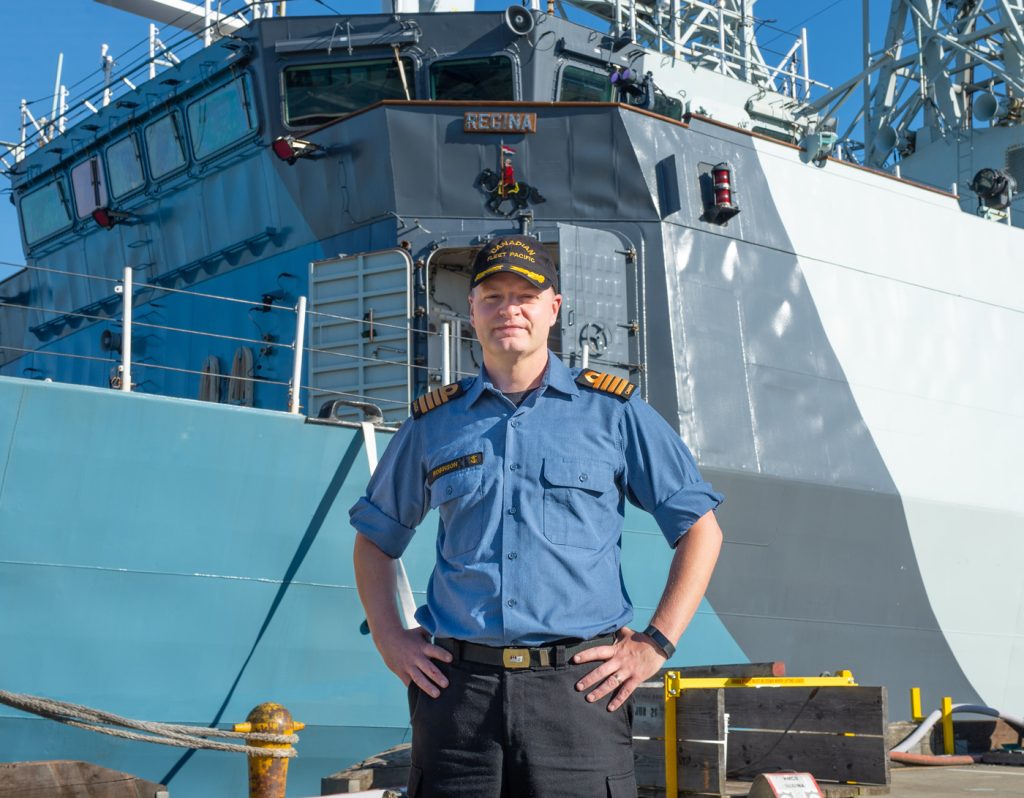The role of the Task Group Commander
By Lookout on Feb 09, 2021 with Comments 0

Captain(Navy) Scott Robinson, Deputy Commander Canadian Fleet Pacific, is the Task Group Commander for Task Group Exercise 21-01
Lt(N) Jeff Klassen
Public Affairs
––
“I haven’t really had time to play video games since my kids were born,” said Captain(Navy) Scott Robinson while under strict quarantine at a local hotel last week. He was able to pass the time playing Red Dead Redemption 2 on his PlayStation 4.
This week he won’t be as relaxed as he takes charge of five Canadian ships, one Canadian submarine, aircraft from two Canadian air force squadrons, and several U.S. Navy and U.S. Coast Guard sea and air assets, all of them performing simultaneous complex maneuvers and exercises in a dynamic maritime environment.
Capt(N) Robinson, who is the Deputy Commander for Canadian Fleet Pacific, is the Task Group Commander for Task Group Exercise (TGEX) 21-01, an exercise that runs from Feb. 8 to 19. It is largely focused on getting West Coast ships and crews ready for upcoming and future deployments.
HMCS Calgary is preparing for its upcoming Operation (Op) Artemis and Op Projection deployment to the Asia-Pacific region and Middle Eastern waters. HMC Ships Brandon and Saskatoon are preparing for their Op Carribe deployments in the eastern Pacific Ocean.
A naval task group is a grouping of maritime vessels and aircraft (ships, subs, helicopters, etcetera) working together towards a common objective. Canada, for example, sent a task group as part of its humanitarian relief after Hurricane Katrina in 2005 (for Op Unison) and as part of relief efforts after the 2010 earthquake in Haiti (for Op Hestia).
The Task Group Commander is in charge of the entire task group. For Capt(N) Robinson, this means coordinating all the scenarios, boardings, and maneuvers during the exercise.
“While ships’ captains are responsible primarily for their own crews, the Task Group staff and I coordinate at the Fleet level to ensure everything is synchronized so we can meet our objectives. The Task Group staff have a critical role in keeping tabs on our ships’ systems, provisions, maintenance, the flying schedule, and liaising with the submarine. We basically make sure the day-to-day business of the fleet runs smoothly.”
TGEX 21-01 is taking place off the west coast of Vancouver Island, Constance Bank, and the Strait of Georgia. Capt(N) Robinson and his task group staff of around 20 people are embedded in HMCS Regina. This makes for a tight squeeze as Regina, besides the regular crew, is also sailing with a sizeable training staff that are mentoring and evaluating the crew’s performance during the exercise.
The Task Group Commander’s staff imitate many of the functions of a single ship’s staff, but are more focused on integrating the various sea and air capabilities so the task group’s effect is greater than the sum of its individual parts.
Within his team are the Chief of Staff, the Battle Watch Team, Future Plans and Current Plans officers, two teams of communications specialists, and group-level Logistics, Technical, and Public Affairs Officers
Among the exercise objectives, is an opportunity to further the submarine HMCS Victoria’s operational readiness program, and provide ships’ crews the chance to fire evolved sea sparrow missiles at unmanned aerial targets.
The exercise is also about maintaining relations with U.S. partners.
“We love having them up here to work with. One thing I was always told is ‘you can’t surge trust’. You need to actually work with your partners often, get to know what each other’s capabilities and limitations are, and develop that relationship ahead of time. When an operational or wartime scenario occurs, you both need to have already built that knowledge and trust.”
As with all aspects of life right now, COVID-19 is having an impact. But because the fleet operates away from the general public this impact is manageable. Among the many precautions taken, all participating Canadian ships’ crews have undergone a quarantine period before sailing. This means, when the exercise is on, personnel can transfer between aircraft and ships, such as in boarding party scenarios.
Unfortunately, any face-to-face interactions with U.S. partners cannot occur.
“Yes, we are losing out on the personal aspect of working together, but we’re still talking to our U.S. partners on radio and interacting with them by other methods. We experienced this during RIMPAC this summer. On that exercise, even when we went to Pearl Harbor, we had to stay on the ship or were isolated on the jetty – we couldn’t interact with people.”
He recognizes how difficult COVID-19 and quarantining can be on people.
During his quarantine, his family were only able to wave to him from 50 feet away while he stood on his hotel room balcony.
“Pre-sail quarantines are never easy, so reach out to your friends, family, and shipmates for support!” he recently tweeted.
––––
Filed Under: Top Stories
About the Author:





